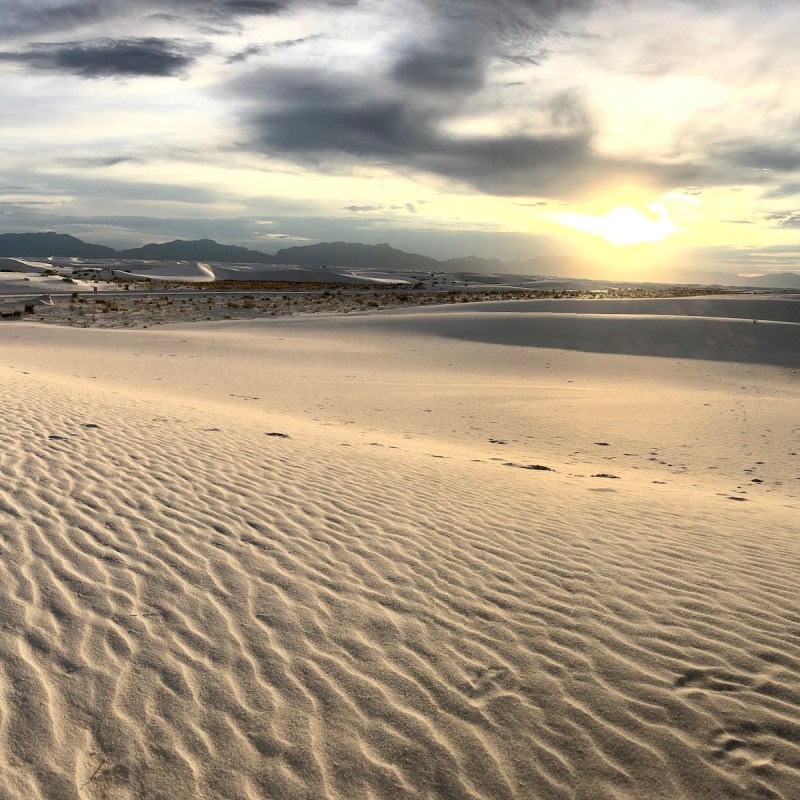
The sand is as white, soft, and fine as any you might find on a tropical Caribbean island. But instead of a backdrop of turquoise water, this sand is surrounded by rugged mountain ranges, desolate desert terrain, and cloud-studded azure skies.
Videos by TravelAwaits
Welcome to southern New Mexico’s resplendent White Sands National Park — a place fittingly described as “unlike anywhere else on earth.”
For miles along your approach to White Sands along New Mexico’s Highway 70, between Las Cruces and Alamogordo, you will catch glimpses of the glistening white sand. The sight is especially tantalizing because of the stark surroundings. White Sands is a 275-square-mile gypsum dune that sits right in the midst of the Tularosa Basin in the Chihuahuan Desert.
Along with being flat-out gorgeous, White Sands holds the distinction of being one of the newest national parks in the United States, having transitioned from a national monument to a national park in December 2019.
Regardless of its designation, White Sands has long offered opportunities for wonderfully unique experiences. Here are nine of the best.

1. Learn The History At The Visitor Center
As with most national parks, the visitor center makes a good first stop. And White Sands’ 1930s-era visitor center is an especially delightful one. The park’s website notes that the building is an excellent example of Spanish Pueblo-style adobe architecture, also known as “Pueblo-Revival.”
The center was built from 1936 to 1938 using local materials. While there, be sure to catch the fascinating film about the history of the dunes, A Land In Motion.

2. Take The Dunes Drive
A scenic drive unlike any other, White Sands’ Dunes Drive bears an uncanny resemblance to a treacherous winter road. But those drifts that form alongside the road and the densely compressed road surface — it’s all sand, not snow.
The first 5 miles of Dunes Drive are paved, and the last 3 miles consist of hard-packed gypsum sand. The road is suitable for cars, motorcycles, and RVs.
Pro Tip: At just 8 miles (16 miles round trip), Dunes Drive is easily navigable. I suggest doing an initial drive-through to take in the sights, and then returning to as many of the stops and trailheads as you have time for.
3. Bicycle On Hard-Packed Sand
If you would rather experience Dunes Drive at a more leisurely pace, bicycling the road is also an option and one that makes for a one-of-a-kind experience.
Biking is allowed on all park roads and parking areas that are open to vehicle use (but not on off-road trails). Cyclists should remember that they will be sharing the narrow road with cars, trucks, and RVs, and take the proper precautions.
Pro Tip: Remember that at 16 miles round-trip, Dunes Drive makes for a bike ride of two hours or more in hot, sunny conditions. The park website recommends wearing sunglasses and sunscreen and bringing at least two liters of water and high-energy snacks along for the bike ride.
4. Hike The Dune Trails
Walking among the dunes is a not-to-be-missed experience of pure pleasure. With the shadowy, jagged peaks of the San Andres and Sacramento mountains visible in the distance, the white sand shimmers all around you.
Thanks to a network of trails rated for difficulty, all visitors should be able to find an appropriate option.
Here, from the easiest to the most difficult are four worthwhile trails at White Sands.

Interdune Boardwalk
If you’re not up for a tough hike up high dunes and through shifting sand, the Interdune Boardwalk is the perfect spot to take in the sights. As its name implies, the 0.4-mile round-trip path is a hard surface boardwalk that is fully accessible for wheelchairs and strollers. Along the way, it provides a nice spot to listen to the birds, observe the lizards, and enjoy the wildflowers. The walk takes about 20 minutes.

Playa Trail
For another easy stroll, the Playa Trail offers a half-mile round-trip route along a flat area toward a small beach area. When I visited in early July, the basin was half-filled with water, making for great reflections of the surrounding dunes. The walk should take about a half hour.

Dune Life Nature Trail
For a scenic trail with appeal for the entire family, head to the Dune Life Nature Trail, where whimsical and informative signs tell the story of the area’s plentiful plants and animals. Rated as moderate, the nature trail consists of a mile-long loop hike. It takes about an hour to complete.

Alkali Flat Trail
Don’t let the word flat fool you. The Alkali Flat Trail is rated as black diamond (strenuous) for its many climbs up steep dunes. Although difficult, Alkali Flat will get you into the middle of the dunes unlike any other trail in the park. The park’s website cautions, “Go only if you are prepared.” The hike takes about 3 hours to complete.

5. Sled The Dunes
White Sands is popular with families for a number of reasons, not the least of which is the sand sledding that is available. On my recent visit, I saw dozens of groups of parents and kids, all toting plastic sleds to the edges of the steep dunes before careening down.
Waxed plastic snow saucers work best and they can be purchased at the park’s gift shop, or visitors can bring their own sleds. The park website recommends finding a dune with a gentle slope and a level runoff at the end.
6. Camp In The Dunes Backcountry
Although there are no established campgrounds in White Sands, the national park typically allows backcountry camping amid the dunes. The website describes the experience as “truly an amazing and memorable experience” of camping among the gypsum dunes under the star-studded night skies.
Pro Tip: Note that as of July 2021, the backcountry camping was closed due to rehabilitation of camping sites.

7. Savor A Sunset
As the sun dips slowly toward the rugged ridges of the San Andres Mountains, the dazzling white sand becomes flushed with a soft rosy hue. Families and couples gather on the dunes to watch as the sky transitions from pink to purple to soft gray.
When I visited in July, the summer monsoon rains were just getting started, and large billowing clouds clung to the horizon, adding to the sunset drama.
There are plenty of great spots to take in the sunset, but I opted to stop at the parking lot that was marked as the Sunset Stroll area. I recommend packing a blanket and a few refreshments and wandering off onto any of the dunes along Dunes Drive. Find a high vantage point that is not blocking someone else’s view, sit down in the soft sand facing west, and watch the show.
It pays to do a quick internet search beforehand to see when the sun will set on the day of your visit. On my recent visit, I arrived in the middle of the afternoon and had plenty of time to take in Dunes Drive and several of the shorter hikes before the scheduled sunset time of 8:17 p.m.
Pro Tip: Although the park’s website lists the closure time as 6 p.m., that refers to the visitor center hours. On my visit, the park’s scenic drive and trails remained open until 9 p.m., allowing visitors to take in the sunset before heading out.
8. Photograph The Dunes
Known to be incredibly photogenic, White Sands attracts droves of photographers — both amateur and professional. The shifting light, shadows, and stunning landscape make the park “a photographer’s paradise,” says the park’s website.
To get the best photos, the park suggests focusing on the “golden hours” — the two hours after sunrise, and the two hours before sunset. Still, every day is different, and you might be surprised, like I was, by gorgeous afternoon clouds hanging on the horizon just above the dunes.
Pro Tip: Because of the danger of blowing sand, the park suggests that photographers take special care with their camera equipment. Photographers should be especially careful while changing camera lenses and always have a camera bag or backpack to store equipment when it is not in use.
9. Explore Alamogordo
White Sands is located about 16 miles southwest of the mid-sized city of Alamogordo, New Mexico, where a host of hotels, fast-food spots, and sitdown restaurants are available.
In addition, the area features a number of fun attractions, including pistachio farm tours at Heart of the Desert/Eagle Ranch Pistachios, the New Mexico Museum of Space, and the White Sands Missile Range Museum.

When To Visit White Sands National Park
Because of its location in southern New Mexico, not far from the Mexico border, White Sands National Park regularly posts sizzling temperatures from late spring through early fall. June and July both have average highs of 97 degrees Fahrenheit, while August is also hot with an average high of 94. Temperatures in May and September climb into the high 80s.
The best months to visit are April and October when averages hover in the high 70-degree range. Still, it’s best to watch the forecasts. On my first visit to the park in early October 2019, temperatures were approaching the 90-degree mark, and the sand was scorching to the touch. On my recent visit in early July 2021, monsoon rains had brought the temperatures down into the 80s, a cool breeze wafted through the dunes, and the sand was damp and cool enough to walk on barefoot.
Pro Tip: For more background on the culture and history of the White Sands area, check out my article 7 Things To Know About White Sands National Park.
New Mexico has a number of unique destinations to enjoy:
